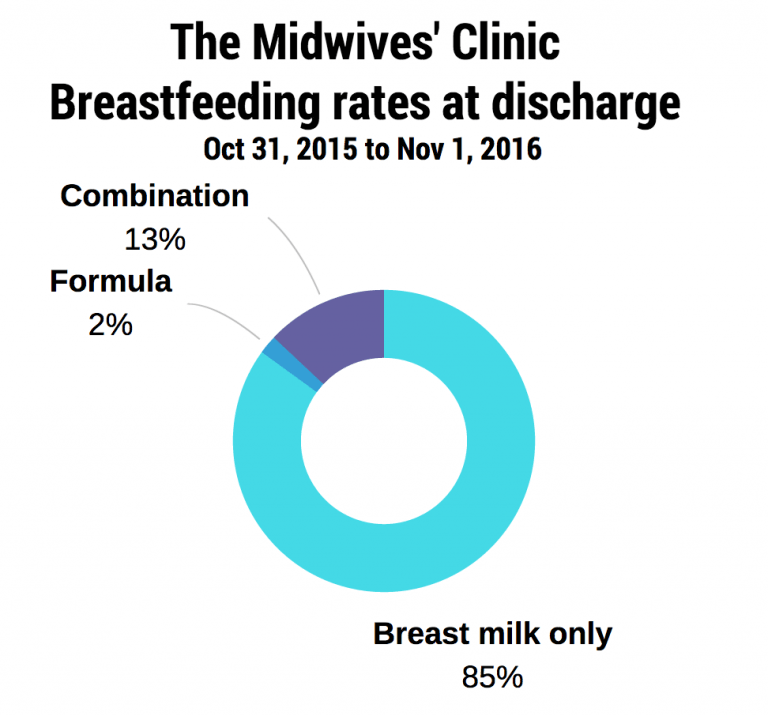Feeding your Baby
Birth – 6 Weeks
Congratulations on the birth of your new baby!
Your midwives will help you and your baby with breastfeeding right after the birth. When you put your baby skin to skin it helps your milk production and the baby’s feeding reflexes are stimulated. Babies are often alert and interested in feeding in the first hour(s) following birth.
During the early days after birth, many babies and clients need time to learn to breastfeed. Don’t be afraid to ask for help.
Your breast milk
Breast milk is the best food you can offer your new baby. The Canadian Paediatric Society recommends exclusive breastfeeding for the first 6 months of life but you can continue breastfeeding your child for much longer.
Breast milk:
Is naturally and uniquely produced by you for your baby. Your baby is less likely to be exposed to foreign allergenic material.
Contains antibodies and other immune factors that help prevent illness, these benefits can last the baby’s lifetime.
Has the right amount and quality of nutrients to meet your baby’s first food needs. Breastmilk continues to change to keep up with a growing baby’s needs.
Is easy on your baby’s digestive system, so there is less chance of constipation or diarrhea.
In the first few days you will be colostrum. Most of the time colostrum is thick and yellowish but it can also be thin and watery. Colostrum is very rich in proteins, vitamins, minerals and infection-fighting antibodies that are found only in breast milk. Even though it is small in quantity it is all your baby needs.
Usually comes in within 3 to 4 days of the birth. The colour becomes more milky white and increases in quantity, and the breasts feel fuller or heavier. When a baby breastfeeds well and often, it really helps milk production and supply.
Latching
Helping the baby get the best latch possible is one of the most important parts of breastfeeding. A good latch can increase milk supply and prevent sore nipples. However, during the early days of breastfeeding it might take time and patience to get the best latch. There are many breastfeeding positions. Don’t be afraid to experiment and find the position that is most comfortable and effective for you and the baby. There are many helpful resources available and your midwives will be visiting often after the birth to offer help and support.
Signs of a good latch
The latch feels comfortable to you, without hurting or pinching. How it feels is more important than how it looks.
Your baby’s chest is against your body and the baby’s head does not have to turn while drinking.
You see little or no areola, this will depend on the size of your areola and the size of your baby’s mouth.
When your baby is positioned well, his or her mouth will be filled with breast.
You hear or see your baby swallow.
You see the baby’s ears ‘wiggle’ slightly.
Your baby’s lips turn out like fish lips, not in. You may not even be able to see the bottom lip.
Your baby’s chin touches your breast.
If you or the baby become frustrated or cry, then stop. Take some deep breathes. Soothe the baby. Try again.
Signs of hunger
Babies will let you know when they are hungry; so watch the baby and not the clock.
Theses are some signs of hunger to look out for but trust yourself because you are the expert on your baby!
Sucking and licking movements of the mouth
Putting hands to the mouth
Stretching and increased body movements
Making small sounds
Rooting (baby turns their head to the right side or left side)
Breastfeed your baby when they are calm and before baby is too hungry and crying.
Growth spurts (more frequent feeds)
Growth spurts are the times your baby grows more quickly and will need more breast milk. These spurts occur frequently in the first few weeks. Feeding patterns change as your baby grows. In the first 6 weeks, your baby will need to feed often. Breastfeed your baby when they show signs of hunger. There are no set times to breastfeed your baby. Most babies will breastfeed at least 8-12 times in 24 hours (day and night). Your breast milk supply will increase to meet your baby’s needs.
There is a drop-in breastfeeding clinic at Michael Garron Hospital that is staffed by lactation consultants and nurses available for all clients:
The Breastfeeding Clinic is located in the Child & Teen Clinic on the main floor of the hospital, G111 in the Mortimer Lobby. It is open six days/week from 10:00 am to 3:00 pm on a drop in basis. The Clinic is closed on Sundays, and statutory holidays. Please call (416) 469-6667 for more information.
Please register in the Admitting Department before coming to the Breastfeeding Clinic. There is no registration on Saturdays, go directly to the clinic.
Helpful Resources
Toronto Public Health list of online resources (Many services are scaled back due to COVID-19, these online resources are available to help)
Michael Garron Hospital Breastfeeding Clinic 416-469-6667
Toronto Public Health Breastfeeding support services
Victoria Park Breastfeeding Clinic, Dr. Muroog Al-Dabbagh, Pediatrician, IBCLC. 1448 Lawrence Avenue East, Toronto, Ontario M4A 2V6. 647-344-5990
Newman Breastfeeding Clinic & Institute
La Leche League Canada
Safely preparing formula for your baby
BFI Safe Formua Prep
International Lactation Consultant Association (Find a Lactation Consultant)

